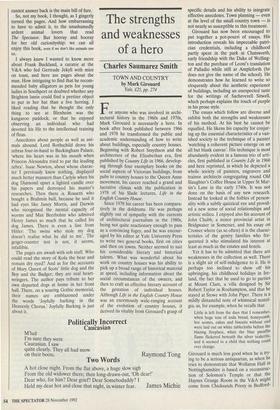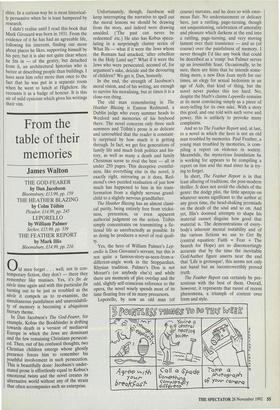The strengths and weaknesses of a hero
Charles Saumarez Smith
TOWN AND COUNTRY by Mark Girouard Yale, US, pp. 274 For anyone who was involved in archi- tectural history in the 1960s and 1970s, Mark Girouard is necessarily a hero. In book after book published between 1966 and 1978 he transformed the public and academic understanding of how to write about buildings, especially country houses. Beginning with Robert Smythson and the architecture of the Elizabethan era, first published by Country Life in 1966, develop- ing through four exemplary books on the social aspects of Victorian buildings, from pubs to country houses to the Queen Anne movement, his career reached a grand and lucrative climax with the publication in 1978 of his Slade lectures, Life in the English Country House.
Since 1978 his career has been compara- tively in the doldrums. He was perhaps slightly out of sympathy with the currents of architectural journalism in the 1980s, being not quite reactionary enough to pass as a convincing fogey, and he was encour- aged by his editor at Yale University Press to write two general books, first on cities and then on towns. Neither seemed to suit his considerable literary and historical talents. What was wonderful about his work on country houses was his ability to pick up a broad range of historical material at speed, including information about the social circumstances of the owners, and then to craft an effective literary account of the gestation of individual houses. Although Life in the English Country House was an enormously wide-ranging account of the evolution of country houses, it derived its vitality from Girouard's grasp of M'lud I'm sure they were Caucasian. I saw quite clearly. They all had snow on their boots.
Raymond Tong
Politically Incorrect
Caucasian
Two Words
A hot close night. From the flat above, a huge slow sigh From the old widower there; then long-drawn-out, 'Oh dear!' Dear who, for him? Dear grief? Dear Somebodaddy? I Held my dear hot and close that night, in winter fear. James Michie specific details and his ability to integrate effective anecdotes. Town planning — even at the level of the small country town — is not nearly so susceptible to this treatment.
Girouard has now been encouraged to put together a pot-pourri of essays. His introduction reveals his impeccable patri- cian credentials, including a childhood partly spent in the park at Chatsworth, early friendship with the Duke of Welling- ton and the purchase of Leoni's translation of Palladio while still at Ampleforth (he does not give the name of the school). He demonstrates how he learned to write so eloquently about the aesthetic experience of buildings, including an unexpected taste for the writings of Sacheverell Sitwell, which perhaps explains the touch of purple in his prose style. The essays which follow are diverse and exhibit both the strengths and weaknesses of his method. At his best he cannot be equalled. He likens his capacity for conjur- ing up the essential characteristics of a van- ished society to the technique of a painter `watching a coherent picture emerge on an all but blank canvas'. His technique is most abundantly evident in a famous trio of arti- cles, first published in Country Life in 1966 and here reprinted, in which he depicted a whole society of painters, engravers and trainee architects congregating round Old Slaughter's Coffee House in Upper St Mar- tin's Lane in the early 1740s. It was not done on the basis of any new research. Instead he looked at the foibles of person- ality with a subtly quizzical eye and provid- ed a new sense of social relationships and artistic milieu. I enjoyed also his account of John Chubb, a minor provincial artist in Bridgwater in Somerset, and his essay on Cromer where (as so often) it is the charac- teristics of the gentry families who fre- quented it who stimulated his interest at least as much as the estates and hotels.
Yet it has to be admitted that there are weaknesses in the collection as well. There is a slight air of self-indulgence to it. He is perhaps too inclined to show off his upbringing, his childhood holidays in Ire- land, the fact that he used to go to parties at Mount Clare, a villa designed by Sir Robert Taylor in Roehampton, and that he stayed at Stowe with John Piper. There is a mildly distasteful note of whimsical nostal- gia, as, for example, when he recalls that Little is left from the days that I remember, when huge teas of soda bread, honeycomb, hot scones, cakes and biscuits without end were laid out on white tablecloths before the blazing fireplace, when the blue paraffin flame flickered beneath the silver teakettle, and it seemed to a child that nothing could ever change.
Girouard is much less good when he is try- ing to be a serious antiquarian, as when he tries to demonstrate that Wollaton Hall in Nottinghamshire is based on a reconstruc- tion of Solomon's Temple or that the Haynes Grange Room in the V&A might come from Chicksands Priory in Bedford- shire. In a curious way he is most historical- ly persuasive when he is least hampered by research.
I didn't realise until I read this book that Mark Girouard was born in 1931. From the evidence of it he has had an agreeable life, following his interests, finding out more about places he likes, supporting himself by his pen; but it is also not quite clear where he fits in — of the gentry, but detached from it, an architectural historian who is better at describing people than buildings. I have seen him refer more than once to the fact that he was put in a separate room when he went to lunch at Highclere. He recounts it as a badge of honour. It is this air of mild cynicism which gives his writings their vim.











































































 Previous page
Previous page